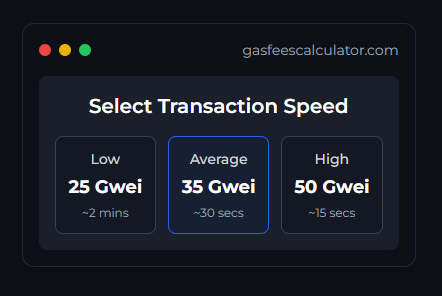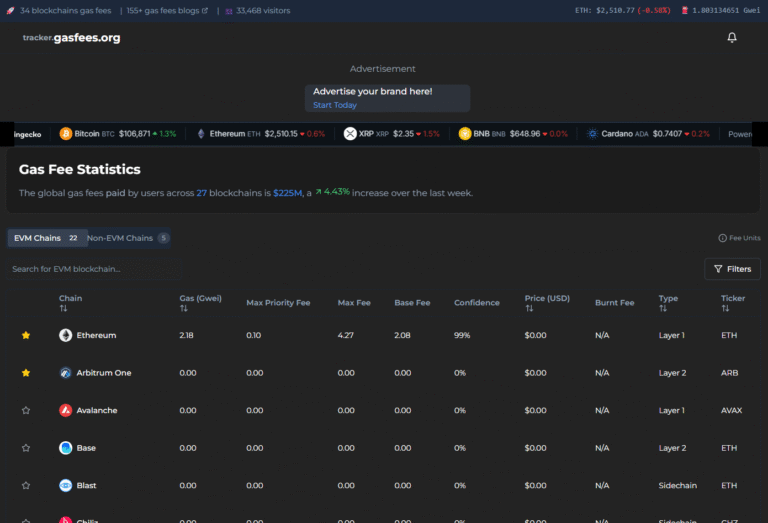
What are solana gas fees?
Quick Reference: 1 SOL = 1,000,000,000 lamports // 1 lamport = 0.000000001 SOL
Solana stands as a beacon of efficiency, offering lightning-fast transaction speeds and a cost-effective ecosystem. At the core of the Solana experience are its gas fees, which play a pivotal role in transaction execution and smart contract interaction on the Solana blockchain.
What Are Solana Gas Fees?
How Are They Calculated?
Typical Costs and Comparisons
Fee Structure Overview
- Base Fee Details: The base fee is set at 5,000 lamports per signature, where 1 SOL equals 1,000,000,000 lamports. At a current SOL price of approximately $160 (as of February 24, 2025, based on recent market data from CoinMarketCap), this translates to about $0.0008 per signature. For transactions with multiple signatures, the base fee scales accordingly, which is crucial for complex operations involving multiple parties or authorizations.
- Prioritization Fee Mechanics: The prioritization fee is calculated using the formula (compute unit limit × compute unit price in micro-lamports) / 1,000,000. Here, the compute unit limit represents the maximum computational resources a transaction can consume, ranging from a default of 200,000 to a maximum of 1,400,000. The compute unit price, set in micro-lamports (where 1 lamport = 1,000,000 micro-lamports), can reach up to 1,000,000 micro-lamports per compute unit, equating to 1 lamport per compute unit at the maximum.
Calculation Examples and Typical Values
Setting Compute Unit Limits and Prices
Comparative Analysis with Other Blockchains
Fee Refunds and Transaction Failures
|
Fee Type
|
Calculation
|
Typical Range (USD)
|
Notes
|
|---|---|---|---|
|
Base Fee
|
5,000 lamports per signature, ≈ $0.0008 at $160/SOL
|
Fixed at $0.0008
|
Charged per signature, scales with multiple signatures
|
|
Prioritization Fee
|
(Compute Unit Limit × Compute Unit Price in micro-lamports) / 1,000,000
|
$0.0015 to $0.047
|
Optional, varies with network demand and user settings
|
|
Total Average Fee
|
Base Fee + Prioritization Fee
|
$0.0024 to $0.048
|
Includes both components, influenced by transaction complexity
|
Conclusion

Mr. GasMan
Blockchain expert specializing in gas fee optimization and network analysis across multiple chains.
Stay informed with curated updates, insights, and tips to help you optimize your transactions across 155+ blockchains.
Solana Gas Fees FAQs
Solana gas fees are the small costs you pay to process transactions on the Solana blockchain. They include a tiny base fee—about $0.0008 per signature—and an optional extra fee if you want your transaction to go through faster. Most transactions end up costing just a few cents!
On average, you’re looking at anywhere from $0.0024 to $0.048 per transaction. It depends on how complex your transaction is and whether you add a priority fee to speed things up. Compared to other blockchains like Ethereum, it’s a steal!
Solana keeps fees low thanks to its super-efficient design, using something called Proof-of-History to handle tons of transactions quickly. That means less congestion and cheaper costs—often just pennies—making it great for everyday use.
Yes! You can stick with the base fee for simple transactions or tweak an optional priority fee to jump the line during busy times. You set how much “compute power” your transaction needs and how much you’re willing to pay for speed—total flexibility.
If your transaction doesn’t go through, you won’t pay anything unless it starts processing and uses some resources. The base fee isn’t refunded if it fails after that, but it’s still just a fraction of a cent, so no big loss.
Yes, fees can go up slightly when the network’s buzzing with activity. The base fee stays fixed at around $0.0008 per signature, but if lots of people are transacting, you might need to add a higher priority fee—still usually under a dime—to get processed faster.





